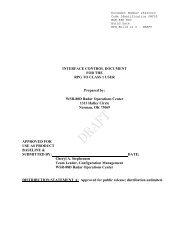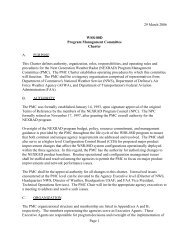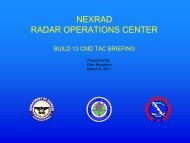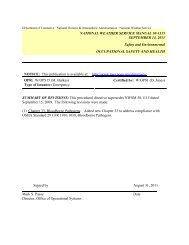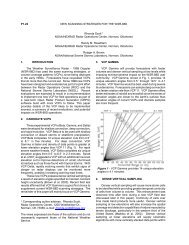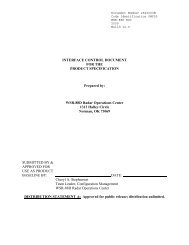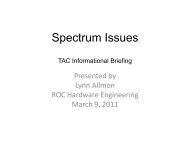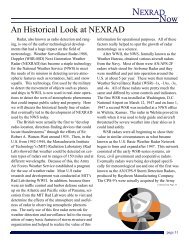WSR-88D and TDWR-SPG Data Status And Plans - NEXRAD Radar ...
WSR-88D and TDWR-SPG Data Status And Plans - NEXRAD Radar ...
WSR-88D and TDWR-SPG Data Status And Plans - NEXRAD Radar ...
Create successful ePaper yourself
Turn your PDF publications into a flip-book with our unique Google optimized e-Paper software.
<strong>WSR</strong>-<strong>88D</strong> <strong>and</strong> <strong>TDWR</strong>-<strong>SPG</strong> <strong>Data</strong><br />
<strong>Status</strong> <strong>And</strong> <strong>Plans</strong><br />
Michael Istok<br />
NWS Office of Science & Technology<br />
<strong>and</strong><br />
Tim Crum<br />
<strong>WSR</strong>-<strong>88D</strong> <strong>Radar</strong> Operations Center<br />
15 January 2009<br />
National Weather Service<br />
Family Of Services/Partners Meeting<br />
Phoenix, AZ
Overview<br />
• Dual Polarization Modification<br />
• Level III Products<br />
• Level II <strong>Data</strong><br />
• <strong>TDWR</strong>-<strong>SPG</strong> <strong>Data</strong>/Products<br />
1/15/09 FOS Meeting 2
Dual Polarization Modification<br />
• Expected improvements in:<br />
– Precipitation estimation<br />
– <strong>Data</strong> quality<br />
– Hail detection<br />
– Rain/snow discrimination<br />
• <strong>Status</strong>: Critical Design Review held in October 2008<br />
1/15/09 FOS Meeting 3
Dual Polarization Modification<br />
(Continued)<br />
• <strong>Plans</strong>:<br />
– Modify NSSL <strong>WSR</strong>-<strong>88D</strong> June 2009<br />
– Modify ROC <strong>WSR</strong>-<strong>88D</strong> April 2010<br />
– Beta Test scheduled to begin 2CY10<br />
– 2-year deployment scheduled to begin 4CY10<br />
• Estimate radar down for two weeks<br />
• Schedule dependent on weather <strong>and</strong> ensuring radar coverage<br />
• ROC will announce deployment schedule when finalized<br />
– Provide sample products, data, draft ICDs, FAQs in advance as<br />
done with Super Resolution data (Build 10)<br />
• New Dual Pol moments to be generated:<br />
– Differential Reflectivity<br />
– Differential Phase<br />
– Correlation Coefficient<br />
1/15/09 FOS Meeting 4
Level III <strong>Status</strong> <strong>and</strong> <strong>Plans</strong><br />
• Build 11<br />
– Beta Test: 16 Mar – 14 May 09; 7 Sites to be announced<br />
– Deployment: Starts 18 May 09<br />
– Major changes for RPCCDS users:<br />
• Severe Weather Probability Product (SWP, Product #47) will<br />
be deleted, ref: TIN 08-94, issued 13 Nov 08<br />
• Implements Clutter Mitigation Decision (CMD) Algorithm<br />
– Automates <strong>and</strong> improves clutter removal (e.g., AP) on a<br />
scan-by-scan basis using new science<br />
– Should reduce use of ALL BINS clutter filtering<br />
1/15/09 FOS Meeting 5
May 7, 2008<br />
Widespread AP<br />
KTLX 21:24:12<br />
No CMD<br />
1/15/09 FOS Meeting 6
May 7, 2008<br />
Widespread AP<br />
KCRI 21:22:16<br />
With CMD<br />
1/15/09 FOS Meeting 7
No CMD filtering<br />
KTLX April 24, 2007 0.5 degrees<br />
CMD controlled filtering<br />
1/15/09 FOS Meeting 8
Level III <strong>Status</strong> <strong>and</strong> <strong>Plans</strong><br />
(Continued)<br />
• Build 12<br />
– RPG software will support non-Dual Pol <strong>and</strong> Dual Pol RDAs<br />
– Beta Test: Starts 2CY10; approximately 8 sites to be announced<br />
– Deployment: Starts October 2010<br />
– Major changes<br />
• Dual Pol <strong>Data</strong> Processing Algorithms <strong>and</strong> products activated<br />
– NWS evaluating which Dual Pol-unique products to be<br />
added to Central Collection data stream<br />
• Legacy Mesocyclone Algorithm removal<br />
• Super Resolution <strong>Data</strong> integrated into Mesocyclone Detection<br />
Algorithm<br />
1/15/09 FOS Meeting 9
Level II <strong>Status</strong><br />
• 121 NWS, 13 DOD <strong>and</strong> 1 FAA Sites on the NWS Level II Network<br />
– No funding available to add remaining 8 CONUS DoD <strong>and</strong> 11<br />
FAA sites; in FY11 funding initiative request<br />
• Evansville (KVWX) transitioned to <strong>WSR</strong>-<strong>88D</strong> software <strong>and</strong> hardware<br />
baseline 1 November 2008<br />
• Super Resolution data:<br />
– Only NWS sites sending Super Resolution Level II data<br />
– NWS expects to add receipt of Super Resolution data from Vance<br />
AFB, Altus AFB, <strong>and</strong> Dyess AFB by April 2009<br />
– No funding available for additional b<strong>and</strong>width needed for Super<br />
Resolution data at other sites; NWS exploring options on how to<br />
provide the additional data<br />
• NWS will provide advance notice when/if able to switch Level II data<br />
flow from DOD <strong>and</strong> FAA sites to Super Resolution or add other sites<br />
1/15/09 FOS Meeting 10
Level II Build 11<br />
CMD Considerations<br />
• Clutter Mitigation Detection (CMD) Algorithm will be implemented in<br />
Build 11; Level II impacts/changes:<br />
– Bypass map in the Level II data metadata changes every volume<br />
scan <strong>and</strong> reflects what was derived <strong>and</strong> used in previous volume<br />
scan, flags in the RDA status message <strong>and</strong> the base data to say<br />
CMD was applied)<br />
– In products, CFC flags indicate if bypass map was derived by<br />
CMD or the legacy, GSM bits to say CMD is running.<br />
– More detail <strong>and</strong> traceability to ICD changes will be sent via a TIN<br />
in February<br />
1/15/09 FOS Meeting 11
Level II <strong>Status</strong><br />
• NWS underst<strong>and</strong>s private sector <strong>and</strong> other users concerns about<br />
reliability of Level II collection <strong>and</strong> distribution; especially regionwide<br />
outages<br />
– Short-term actions<br />
• Improving frequency of feed back on restoration status <strong>and</strong><br />
conveying to TOC email list<br />
• Replaced DS3 connection from NWS ER HQ to NWS HQ<br />
with NOAANet<br />
– Longer-term actions<br />
• Improve underst<strong>and</strong>ing of user data delivery reliability<br />
requirements<br />
• Consider using user resources to meet requirements<br />
• Improve reliability through new planned architecture<br />
1/15/09 FOS Meeting 12
Level II <strong>Data</strong> <strong>Plans</strong><br />
• NWS beginning work to change Level II data collection <strong>and</strong><br />
distribution architecture<br />
– Tentative design: Use NOAANet to send data to two national-level<br />
aggregation points (redundancy) with 24/7 support available<br />
– Should provide increased data delivery reliability<br />
– Additional information<br />
• No implementation date set; target first half 2010<br />
• Plan to continue to send data to top tier sites<br />
• NWS will keep top tier sites <strong>and</strong> Level II users updated on planning<br />
<strong>and</strong> implementation<br />
1/15/09 FOS Meeting 13
1/15/09 FOS Meeting 14<br />
Drawing Courtesy Jami Casamento
Possible New Level II Architecture<br />
Top Tier<br />
LDM<br />
Server<br />
OU<br />
ERC<br />
ERC/NCDC<br />
Top Tier<br />
LDM Server<br />
N<br />
E<br />
X<br />
R<br />
A<br />
D<br />
s<br />
NOAANet<br />
NOAANet<br />
MPLS<br />
MPLS<br />
Backbone<br />
Backbone<br />
OC3<br />
OC3<br />
Primary<br />
Natl<br />
LDM<br />
Server<br />
Farm<br />
Backup<br />
Natl<br />
LDM<br />
Server<br />
Farm<br />
Location TBD<br />
Existing<br />
GigaPop<br />
Internet2<br />
Internet2<br />
(Abilene)<br />
(Abilene)<br />
Purdue<br />
Top Tier<br />
LDM<br />
Server<br />
Gigabit Ethernet<br />
TOC<br />
LDM<br />
Server<br />
Farm<br />
Backup<br />
TOC<br />
LDM<br />
Server<br />
Farm<br />
Maryl<strong>and</strong><br />
University (MAX)<br />
GigaPop<br />
Top Tier<br />
LDM<br />
Server<br />
1/15/09 FOS Meeting 15<br />
Silver Springs
Level II <strong>Data</strong> <strong>Plans</strong><br />
(Continued)<br />
• Not determined if Dual Pol data will be added to Level II <strong>Data</strong><br />
Collection <strong>And</strong> Distribution Network when Dual Pol deployed<br />
– Additional b<strong>and</strong>width; estimated 512 kbps/radar (ave. 360 kbps)<br />
• B<strong>and</strong>width <strong>and</strong> total increase of data flow dependent on Dual<br />
Pol collection strategy implemented<br />
– NWS goal to distribute Dual Pol Level II data<br />
• NWS exploring options on how to provide the additional data<br />
1/15/09 FOS Meeting 16
Dual Pol Level II Impacts<br />
• Current Level II Throughput with Build 10 Super-Res<br />
– Varies from 10 to 180 kbps per radar hourly average throughput<br />
– Network hourly average 1 to 7 mbps (Seasonal Maxima in August 08’)<br />
• Level II data content with Dual Polarization<br />
– Three new fields added to Message 31 base data radials<br />
• Differential Reflectivity, Correlation Coefficient, Differential Phase<br />
• Provided on the first cut of each elevation angle<br />
• Range resolution of 250m <strong>and</strong> coverage range of 300km<br />
• Azimuth resolution of 0.5 degrees on low elevation split cuts, 1 deg above<br />
– 250m Reflectivity <strong>and</strong> 300km Doppler data will be extended to all cuts<br />
– Metadata changes will include VCP, <strong>Status</strong>/Alarms, P/M data<br />
– Comms link (funding) constraints may drive Recombination <strong>and</strong> Removal<br />
– Level II version numbers will be extended to indicate new data content<br />
• Dual Polarization will Double Level II <strong>Data</strong> Throughput<br />
– Worst Case of VCP 12/212 can reach volume scan average of 378 kbps<br />
– Comms links of 384kbps might h<strong>and</strong>le load but would have some added latency<br />
(~30 seconds) during widespread significant weather<br />
– Network hourly average seasonal maxima estimated to reach 14 mbps.<br />
1/15/09 FOS Meeting 17
Super-Res Level II <strong>Data</strong><br />
1/15/09 FOS Meeting 18
Super-Res Level II <strong>Data</strong><br />
1/15/09 FOS Meeting 19
Super-Res Level II <strong>Data</strong><br />
1/15/09 FOS Meeting 20
Level II Total Throughput<br />
(before Super-Res)<br />
1/15/09 FOS Meeting 21
Impact of Super-Res on Level II<br />
1/15/09 FOS Meeting 22
Super-Res Level II <strong>Data</strong> Throughput<br />
1/15/09 FOS Meeting 23
Super-Res Level II Burst Rate/Latency<br />
1/15/09 FOS Meeting 24
Dual Pol Level II Burst Rate/Latency<br />
(8/19/07 Super-Res Case Extrapolated to Dual Pol)<br />
1/15/09 FOS Meeting 25
<strong>TDWR</strong>-<strong>SPG</strong> <strong>Status</strong> <strong>and</strong> <strong>Plans</strong><br />
• Beta test of FAA <strong>TDWR</strong> product collection <strong>and</strong> distribution from<br />
Supplemental Product Generator (<strong>SPG</strong>) started 18 Nov 08<br />
– <strong>SPG</strong> emulates RPG function to generate products<br />
– Details in TIN 08-85, 16 Oct 08<br />
– 6 <strong>TDWR</strong>-<strong>SPG</strong>s connected as of end of December<br />
• Full-scale deployment dependent on installation of new AWIPS<br />
software (OB9); targeted “ramp up”:<br />
– January 2009: up to 8 sites<br />
– March 2009: up to 30 sites<br />
– June 2009: full implementation (45 sites)<br />
– Schedule will be posted at:<br />
ftp://ftp.roc.noaa.gov/Pub/<strong>TDWR</strong>_<strong>SPG</strong>_INFO/<br />
1/15/09 FOS Meeting 26
<strong>TDWR</strong>-<strong>SPG</strong> <strong>Status</strong> <strong>and</strong> <strong>Plans</strong><br />
(Continued)<br />
• NWS plans to display <strong>TDWR</strong>-<strong>SPG</strong> products with RIDGE version 2<br />
beta test in February 2008<br />
– Announcement of data availability <strong>and</strong> location will be made in<br />
advance<br />
• NWS will combine <strong>TDWR</strong>-<strong>SPG</strong> product availability status <strong>and</strong> Free<br />
Text Messages to a new <strong>Radar</strong> Site <strong>Status</strong> page<br />
– Announcement of data availability will be made in advance;<br />
planning to use URL currently used<br />
• <strong>TDWR</strong> Level II data collection <strong>and</strong> distribution uncertain due to<br />
funding; NWS exploring options on how to provide the additional data<br />
1/15/09 FOS Meeting 27
New RPCCDS <strong>Status</strong> Page<br />
1/15/09 FOS Meeting 28
RIDGE2 display of <strong>TDWR</strong> <strong>SPG</strong><br />
1/15/09 FOS Meeting 29
<strong>TDWR</strong> Sites<br />
45 <strong>TDWR</strong>s procured for<br />
large airports with<br />
significant exposure to<br />
LAWS<br />
1/15/09 FOS Meeting 30
Improvement<br />
≤ 500 m<br />
500 – 1000 m<br />
1000 – 1500 m<br />
1500 – 2000 m<br />
2000 – 2500 m<br />
Improvement in Minimum Height Above Ground of <strong>Radar</strong> Coverage: <strong>TDWR</strong> Added To <strong>WSR</strong>-<strong>88D</strong><br />
1/15/09 FOS Meeting 31
# NNN WMO<br />
<strong>Radar</strong><br />
Prod<br />
Code<br />
<strong>TDWR</strong> Level III <strong>Plans</strong><br />
<strong>TDWR</strong> <strong>SPG</strong> Product Collection<br />
<strong>Radar</strong> Product Name Kbytes Frequency NWSTG<br />
Distribution<br />
NWSTG<br />
RPCCDS FTP<br />
Dir Name<br />
1 GSM NXUS6i 2 General <strong>Status</strong> Message(GSM) 0.1 ~ 5/day RPCCDS & SBN DS.p2gsm<br />
2 FTM NOUS6i 75 Free Text Message(FTM) 0.3 < 1/day RPCCDS & SBN DS.75ftm<br />
3 RSL SDUS4i 152 Archive <strong>Status</strong> Product(ASP) 3 3/day RPCCDS & SBN DS.152rs<br />
4 TZL SDUS5i 186 Reflectivity (Z) - 0.6 deg Long Range - 8bit 80 10/hr RPCCDS & SBN DS.186zl<br />
5 TR0 SDUS5i 181 Reflectivity (Z) - Lowest elev - 4bit 25 10/hr RPCCDS & SBN DS.181r0<br />
6 TR1 SDUS2i 181 Reflectivity (Z) - 1.0 deg - 4bit 14 10/hr RPCCDS & SBN DS.181r1<br />
7 TR2 SDUS2i 181 Reflectivity (Z) - 3rd elev- 4bit 12 10/hr RPCCDS & SBN DS.181r2<br />
8 TV0 SDUS5i 182 Velocity (V) - Lowest elev - 8bit 90 10/hr RPCCDS & SBN DS.182v0<br />
9 TV1 SDUS7i 182 Velocity (V) - 1.0 deg - 8bit 70 10/hr RPCCDS & SBN DS.182v1<br />
10 TV2 SDUS7i 182 Velocity (V) - 3rd elev - 8bit 45 10/hr RPCCDS & SBN DS.182v2<br />
11 NCR SDUS5i 37 Composite Ref (CZ) 20 10/hr RPCCDS & SBN DS.p37cr<br />
12 NET SDUS7i 41 Echo Tops (ET) 1.5 10/hr RPCCDS & SBN DS.p41et<br />
13 NVW SDUS3i 48 VAD Wind Profile (VWP) 7.5 10/hr RPCCDS & SBN DS.48vwp<br />
14 NVL SDUS5i 57 Vert Integ Liq (VIL) 1.3 10/hr RPCCDS & SBN DS.57vil<br />
15 NST SDUS6i 58 Storm Tracking Information (STI) 3.5 10/hr RPCCDS DS.58sti<br />
16 NHI SDUS6i 59 Hail Index (HI) 3.2 10/hr RPCCDS DS.p59hi<br />
17 NTV SDUS6i 61 Tornadic Vortex Signature (TVS) 2.1 10/hr RPCCDS DS.61tvs<br />
18 N1P SDUS3i 78 One Hour Precip (OHP) 10 10/hr RPCCDS & SBN DS.78ohp<br />
19 NTP SDUS5i 80 Storm Total Precip (STP) 11 10/hr RPCCDS & SBN DS.80stp<br />
20 DPA SDUS8i 81 Digital Precip Array (DPA) 7 10/hr RPCCDS & SBN DS.81dpr<br />
21 SPD SDUS6i 82 Supplemental Precipitation <strong>Data</strong> (SPD) 2.8 10/hr RPCCDS DS.82spd<br />
22 DHR SDUS5i 32 Digital Hybrid Scan Refl (DHR) 32 10/hr RPCCDS & SBN DS.32dhr<br />
23 DSP SDUS5i 138 Digital Storm Total Precip (STP) 15 10/hr RPCCDS & SBN DS.138dp<br />
24 NMD SDUS3i 141 Mesocyclone (MD) 2 10/hr RPCCDS & SBN DS.141md<br />
1/15/09 FOS Meeting 32
WFO<br />
#<br />
<strong>SPG</strong>s<br />
@ wfo<br />
<strong>TDWR</strong> Level III <strong>Plans</strong><br />
<strong>TDWR</strong> <strong>SPG</strong> IDs, Sending WFOs, FTP dir names<br />
Sending<br />
WFO ID<br />
CCCC<br />
<strong>TDWR</strong><br />
<strong>SPG</strong> ID<br />
xxx<br />
<strong>TDWR</strong><br />
<strong>SPG</strong> ID<br />
<strong>Radar</strong><br />
FTP Site<br />
directory<br />
<strong>SPG</strong> # WFO<br />
#<br />
<strong>SPG</strong>s<br />
@ wfo<br />
Sending<br />
WFO ID<br />
CCCC<br />
<strong>TDWR</strong><br />
<strong>SPG</strong> ID<br />
xxx<br />
<strong>TDWR</strong><br />
<strong>SPG</strong> ID<br />
<strong>Radar</strong><br />
FTP Site<br />
directory<br />
1 1 KBOU DEN 3013 SI.tden 1 KLWX ADW 3001 SI.tadw 22<br />
2 1 KBOX BOS 3004 SI.tbos 2 KLWX BWI 3005 SI.tbwi 23<br />
17 4<br />
3 1 KCLE LVE 3006 SI.tlve 3 KLWX DCA 3012 SI.tdca 24<br />
4 1 KDTX DTW 3015 SI.tdtw 4 KLWX IAD 3019 SI.tiad 25<br />
5 1 KEAX MCI 3025 SI.tmci 5 18 1 KMEG MEM 3028 SI.tmem 26<br />
6 1 KFFC ATL 3002 SI.tatl 6 KMFL FLL 3017 SI.tfll 27<br />
7 2<br />
KFWD DAL 3010 SI.tdal 7 19 3 KMFL MIA 3029 SI.tmia 28<br />
KFWD DFW 3014 SI.tdfw 8 KMFL PBI 3035 SI.tpbi 29<br />
8 1 KGSP CLT 3007 SI.tclt 9 20 1 KMKX MKE 3030 SI.tmke 30<br />
9 2<br />
KHGX HOU 3018 SI.thou 10 21 1 KMLB MCO 3026 SI.tmco 31<br />
KHGX IAH 3020 SI.tiah 11 22 1 KMPX MSP 3031 SI.tmsp 32<br />
10 1 KICT ICH 3021 SI.tich 12 23 1 KOHX BNA 3003 SI.tbna 33<br />
KILN CMH 3008 SI.tcmh 13 KOKX EWR 3016 SI.tewr 34<br />
24 2<br />
11 3 KILN CVG 3009 SI.tcvg 14 KOKX JFK 3023 SI.tjfk 35<br />
KILN DAY 3011 SI.tday 15 25 1 KOUN OKC 3033 SI.tokc 36<br />
12 1 KIND IDS 3022 SI.tids 16 26 1 KPBZ PIT 3038 SI.tpit 37<br />
13 1 KLIX MSY 3032 SI.tmsy 17 27 1 KPHI PHL 3036 SI.tphl 38<br />
14 1 KLMK SDF 3040 SI.tsdf 18 28 1 KPSR PHX 3037 SI.tphx 39<br />
15 2<br />
KLOT MDW 3027 SI.tmdw 19 29 1 KRAH RDU 3039 SI.trdu 40<br />
KLOT ORD 3034 SI.tord 20 30 1 KSLC SLC 3042 SI.tslc 41<br />
16 1 KLSX STL 3043 SI.tstl 21 31 1 KTBW TPA 3044 SI.ttpa 42<br />
32 1 KTSA TUL 3045 SI.ttul 43<br />
33 1 KVEF LAS 3024 SI.tlas 44<br />
34 1 TJSJ SJU 3041 SI.tsju 45<br />
<strong>SPG</strong><br />
#<br />
1/15/09 FOS Meeting 33
<strong>TDWR</strong> Level III <strong>Plans</strong><br />
Product Throughput per <strong>Radar</strong><br />
1/15/09 FOS Meeting 34
<strong>Radar</strong> Product Collection<br />
Content <strong>and</strong> Throughput<br />
• Current Level III RPCCDS<br />
– Varies from 3 to 21 kbps per radar hourly average throughput<br />
– Network hourly average 0.5 to 1.6 mbps (Seasonal Maxima in August)<br />
– 25,000 to 65,000 products per hour<br />
• RPCCDS content with <strong>TDWR</strong> <strong>SPG</strong> Products<br />
– 24 new products per radar added to the 10 second product bundles<br />
• Base Products (up to 3 elevations), Precipitation, Storm Analysis, Derived<br />
• Adds 252 products per hour at a throughput of 5 to 15 kbps per radar<br />
• 45 <strong>TDWR</strong>s will add 9,500 products per hour at throughput of 256 to 512 kbps<br />
– Archived at NCDC <strong>and</strong> most on NOAAPORT<br />
– Total RPCCDS may reach 74,500 products/hour at a throughput of 2 mbps<br />
• Dual Polarization will at least Double Level III Product Throughput<br />
– Will depend on which products, elevations, resolutions are selected<br />
– Requirements formulation in progress<br />
1/15/09 FOS Meeting 35
RPCCDS<br />
1/15/09 FOS Meeting 36
RPCCDS w/ <strong>TDWR</strong><br />
1/15/09 FOS Meeting 37
Additional Information<br />
• Project updates <strong>and</strong> other Level II information:<br />
– http://www.roc.noaa.gov/NWS_Level_2<br />
• NWS Real-Time <strong>WSR</strong>-<strong>88D</strong> Transmit/Receive <strong>Status</strong>:<br />
– http://weather.noaa.gov/monitor/radar/<br />
– Soon to include <strong>TDWR</strong> data flow status <strong>and</strong> FTMs<br />
• NWS Real-Time Level II <strong>Data</strong> Monitoring Site:<br />
– http://weather.noaa.gov/monitor/radar2/<br />
• <strong>WSR</strong>-<strong>88D</strong> Software/Program updates for product users:<br />
– http://www.nws.noaa.gov/tg/rpccds.html<br />
• Build specific training materials:<br />
– http://www.wdtb.noaa.gov/<br />
1/15/09 FOS Meeting 38
Additional Information<br />
(Continued)<br />
• NCDC <strong>Radar</strong> Resources: Order Level II <strong>and</strong> Level III (including<br />
<strong>TDWR</strong>) Archive <strong>Data</strong> Via FTP, Use NCDC Java Viewer to View<br />
Level II <strong>and</strong> Level III Archive <strong>Data</strong>, etc.<br />
– http://www.ncdc.noaa.gov/oa/radar/radarresources.html<br />
• Run RPG Software, LINUX Platform: The Common Operations <strong>and</strong><br />
Development Environment (CODE)<br />
– http://www.weather.gov/CODE<strong>88D</strong><br />
• Federal Meteorological H<strong>and</strong>book No. 11 (FMH-11) Part A Updated<br />
for Build 11 will be available electronically in May<br />
– http://www.ofcm.gov/homepage/text/pubs.htm<br />
• Follow-up questions to: Michael.Istok@noaa.gov or<br />
Tim.D.Crum@noaa.gov<br />
1/15/09 FOS Meeting 39
<strong>TDWR</strong> Level III <strong>Plans</strong> – Backup Slide<br />
<strong>TDWR</strong> System Overview<br />
1/15/09 FOS Meeting 40
<strong>TDWR</strong> Level III <strong>Plans</strong> – Backup Slide<br />
Differences from <strong>WSR</strong>-<strong>88D</strong><br />
• <strong>TDWR</strong> is C-b<strong>and</strong><br />
– Significant Attenuation at times<br />
– More range <strong>and</strong> velocity folding<br />
• Aggressive clutter filtering<br />
• <strong>WSR</strong>-<strong>88D</strong> beamwidth is 1 degree, whereas <strong>TDWR</strong> is ½ degree<br />
– <strong>TDWR</strong> computes radial data at 1 degree azimuths, but still vertically narrow<br />
• Scan Strategies / Volume Coverage Patterns (VCP)<br />
– <strong>TDWR</strong> scan strategy elevation angles are site specific<br />
– Higher elevation angles <strong>and</strong> larger intervals between elevations<br />
– <strong>SPG</strong> translates <strong>TDWR</strong> Hazardous <strong>and</strong> Monitor modes to VCP 80 <strong>and</strong> 90, respectively. Both<br />
are 6 minutes in duration.<br />
– Some elevations angles in VCP 80 repeat during the volume scan<br />
• <strong>TDWR</strong> Spatial resolution <strong>and</strong> coverage area provided by <strong>SPG</strong><br />
– Long range surveillance scan is at 300m resolution to 225 nmi range<br />
– All other elevations are at 150m resolution <strong>and</strong> extend to 45 nmi<br />
– Product range is 45nmi, except for rainfall products, <strong>and</strong> long range base Refl<br />
– <strong>SPG</strong> product VS time varies within a volume to distinguish product repeats<br />
1/15/09 FOS Meeting 41
<strong>TDWR</strong> Level III <strong>Plans</strong> – Backup Slide<br />
VCP Elevation Scan Coverage Comparison<br />
1/15/09 FOS Meeting 42
Bin<br />
<strong>TDWR</strong> Level III <strong>Plans</strong> – Backup Slide<br />
<strong>TDWR</strong> <strong>SPG</strong> Algorithm/Product Processing<br />
Angle<br />
# Angle Min Max 90 80 2200 2200 2206 2207 2208 2209 2210 2211 2212<br />
25 60.0 57.6 62.5 60.0 16<br />
24 55.0 52.6 57.5 55.1 15<br />
23 50.0 47.6 52.5 50.2 14<br />
22 45.0 42.6 47.5 45.3 13<br />
21 40.0 37.6 42.5 40.4 42.0 12 12 21<br />
20 35.0 32.6 37.5 35.5 11<br />
19 30.0 27.6 32.5 30.6 28.1 10 11 20<br />
18 25.0 22.1 27.5 25.7 9<br />
17 19.5 18.0 22.0 20.8 19.4 8 9 19<br />
16 16.7 15.7 17.9 15.9 7<br />
15 14.0 13.1 15.6 13.4 8 17<br />
13 10.0 9.6 11.0 11.0 10.0 6 7 16 2<br />
10 6.0 5.7 6.6 6.1 6.6 5 5 15 1<br />
7 3.4 2.7 3.6 3.3 3.3 4 4 13<br />
3 0.9 0.8 1.1 1.0 1.0 3 3 ---> ---> 3 R 2<br />
2 0.5 0.4 0.8 0.6 0.6 1 1 ---> ---> ---> 1 R 1<br />
2 0.5 0.4 0.8 0.5 0.5 2 2 6 10 14 18 22<br />
AWIPS Binning Scheme<br />
tbwi example<br />
VCP<br />
90<br />
<strong>TDWR</strong> <strong>SPG</strong> (Product Time)<br />
80<br />
bwi<br />
VNUM 1<br />
2<br />
Algorithms/Products run on<br />
scans as indicated by cell<br />
side boarder (1 per 6<br />
minute PPS, ULR, VWP),<br />
top (derived mini-vol), <strong>and</strong><br />
patterns (storm analysis<br />
mini-volume).<br />
PPS: Long Range Cut<br />
VWP: Last Cut of Each<br />
Short Range Angle<br />
ULR: Every Cut<br />
STI, HI, MD, TVS, cat:<br />
Cut #'s as noted & reuse<br />
1.0 deg cut<br />
CR, VIL, ET: Cut #'s as<br />
noted & reuse 1.0 deg<br />
<strong>and</strong> Long Range cut<br />
Product Times (top) of Base<br />
Product Elevation Cuts<br />
indicated by cell color<br />
1/15/09 FOS Meeting 43<br />
10/ 14/20 08



